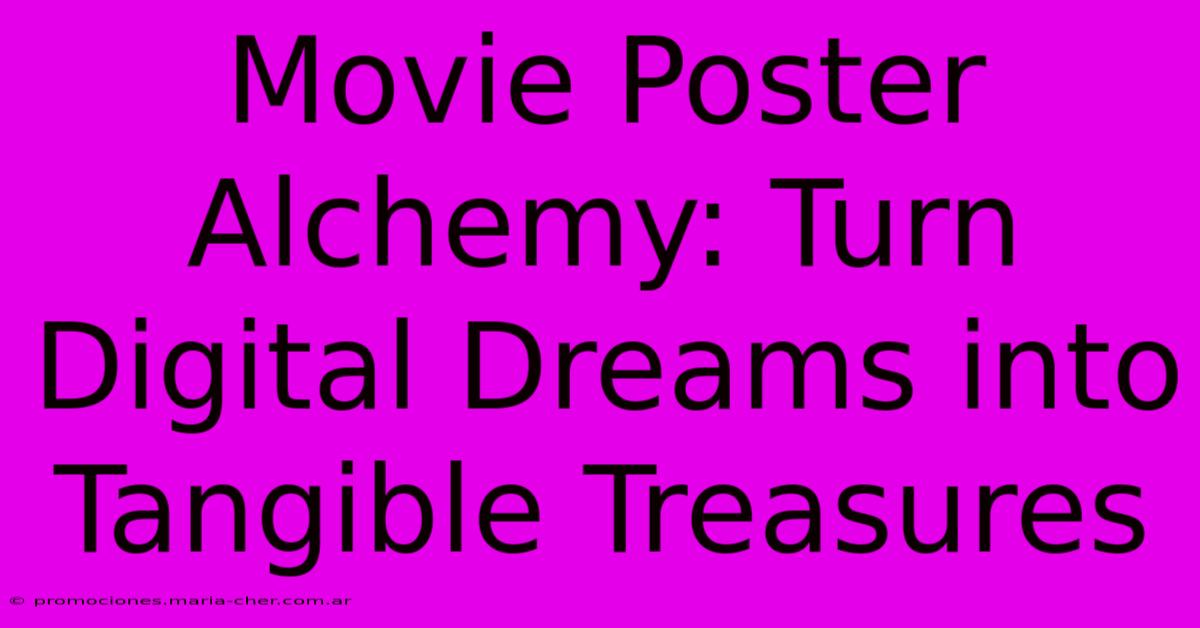Movie Poster Alchemy: Turn Digital Dreams Into Tangible Treasures

Table of Contents
Movie Poster Alchemy: Turn Digital Dreams into Tangible Treasures
Movie posters. They're more than just advertisements; they're iconic pieces of art that capture the essence of a film, igniting anticipation and sparking conversation. In the digital age, creating stunning movie posters is easier than ever, but transforming those digital dreams into tangible treasures is where the true alchemy begins. This guide will walk you through the process, from perfecting your digital design to holding your very own printed masterpiece.
From Pixel to Print: Mastering the Digital Design
Before you even think about printing, your digital design needs to be perfect. This means understanding the nuances of poster design and leveraging the right tools.
Understanding the Essentials:
- High Resolution is Key: Aim for a resolution of at least 300 DPI (dots per inch). Anything less will result in a blurry, unprofessional-looking print. Remember, you're aiming for a large format print, so low resolution will be magnified dramatically.
- Color Profile Matters: Use a color profile like sRGB for web display and Adobe RGB for print to ensure accurate color representation. This prevents your vibrant digital masterpiece from looking dull in print.
- File Format Selection: Save your final design as a high-resolution PDF or TIFF file. These formats preserve the quality and integrity of your image better than JPEG.
- Typography Triumphs: Choose fonts that are both legible and visually appealing at a distance. Avoid overly ornate fonts that may appear muddled when printed.
Essential Software and Tools:
- Adobe Photoshop: The industry standard for image editing and manipulation. Its powerful features are invaluable for creating and refining your movie poster design.
- Adobe Illustrator: Perfect for creating vector graphics, ensuring crisp lines and sharp text even at large sizes.
- GIMP (GNU Image Manipulation Program): A free and open-source alternative to Photoshop, offering a robust set of tools for image editing.
The Art of Printing: Choosing the Right Method and Materials
Now that your digital design is polished, it's time to bring it to life through printing. The choice of printing method significantly impacts the final product's quality and cost.
Printing Options Unveiled:
- Offset Printing: Ideal for large print runs, offering vibrant colors and high-quality results at a cost-effective price per unit. This is the standard for large-scale movie poster production.
- Digital Printing: Perfect for smaller print runs or when quick turnaround is crucial. The cost per unit is higher than offset printing but offers flexibility.
- Giclée Printing: A high-quality inkjet printing method using archival inks, resulting in exceptionally detailed and long-lasting prints. Excellent for collectors' items and limited edition posters.
Paper Selection: The Unsung Hero:
The paper you choose will drastically impact the final look and feel of your poster. Consider the following factors:
- Weight: Heavier weight paper (e.g., 100lb or above) provides a more substantial feel and is less prone to creasing.
- Texture: The texture of the paper adds character and can enhance the overall aesthetic of your poster.
- Finish: Glossy finishes offer vibrant colors but can be prone to fingerprints. Matte finishes provide a more subdued look but are less reflective.
Beyond the Print: Protecting Your Precious Poster
Once your beautiful movie poster is printed, you need to protect your investment.
Preservation Techniques:
- Framing: A high-quality frame protects your poster from damage, UV rays, and dust. Choose a frame that complements the poster's style.
- Laminating: Laminating adds an extra layer of protection against moisture and scratches, enhancing longevity.
- Archival Storage: If you're not planning to display the poster immediately, store it flat in an acid-free sleeve or portfolio to prevent damage.
Turning your digital movie poster design into a tangible treasure is a rewarding process. By following these steps and paying attention to detail, you can ensure your creation looks its absolute best for years to come. From the initial digital design to the final framing, each stage contributes to the magic of transforming your digital dreams into tangible treasures.

Thank you for visiting our website wich cover about Movie Poster Alchemy: Turn Digital Dreams Into Tangible Treasures. We hope the information provided has been useful to you. Feel free to contact us if you have any questions or need further assistance. See you next time and dont miss to bookmark.
Featured Posts
-
Polaroid Dimensions Demystified A Photographers Blueprint For Success
Feb 08, 2025
-
Blooming On A Budget Lily Of The Valley Bouquets That Wont Break The Bank
Feb 08, 2025
-
The Secret Weapon Discover How Floral Tape Can Elevate Your Floral Creations
Feb 08, 2025
-
Spread Romance And Joy Bulk Rose Petals For Valentines Day And Beyond
Feb 08, 2025
-
Escape Into Luxury Discover The Enchanting World Of Escada Handbags
Feb 08, 2025
